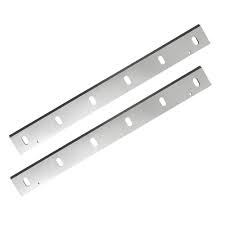When using any power tools, playing it safe should always be the name of the game. Fitting and using planer blades correctly keeps you and your projects in one piece. This guide breaks it down into simple steps both beginners and experts should follow.
Before messing with the blades, unplug the planer. No exceptions here – better safe than missing a finger! This eliminates any chance of accidentally turning it on while your hands are in harm’s way.
There are two main ways planer blades are held in place. Some use clamping plates that bolt down on top of the blade block to lock them down tight. Others have blade holders that wedge into slots in the block and get tightened with jacking screws or bolts. Either way, the holders have ridges that match up with grooves on the back of the blades for easy alignment.
Before installing new blades, take a minute to clean out any sticky resin or sawdust that might be stuck in the clamps or block. Grab a cleaner made specifically for tools and give any dirty spots a good spritzing. Let it sit for a few, then scrub with a brass brush. Wipe it all down with a cloth and you’re good to go.
With everything clean, put the blades into position, lining up the groove on the back of each blade with the ridges on the holder. Slide them in until centred. If your planer can also do rebating, adjust the blades accordingly.
For dual purpose planers, accurately aligning the blades is super important. Use a straightedge on the edge of the sole plate and move the cutter until it lines up just right. Once aligned perfectly, lock the holder firmly in place. And here’s a hot tip from the pros: slightly projecting one or both blades past the sole edge can improve planing and prevent uneven spots.
By taking the time to fit and adjust your planer blades correctly, you’ll get better performance from your planer and keep all your digits intact. Remember – a few extra minutes upfront prevents accidents down the line. Whether you’re a new woodworker or seasoned pro, never take shortcuts when it comes to safety. Your craft and your hands will thank you!



